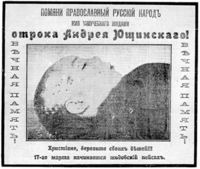More actions
Bot: Automatski unos stranica |
m Bot: Automatska zamjena teksta (-{{Cite book +{{Citiranje knjige) |
||
| Redak 1: | Redak 1: | ||
<!--'''Krvna kleveta'''-->[[Datoteka:1910s_antisemitic_flier_Andrei_Yushchinsky.jpg|mini|200px|Plakat iz Kijeva, 1910 sa natpisom "Kršćani, pazite svoju djecu: 17. ožujka će biti [[Pasha]]]] | <!--'''Krvna kleveta'''-->[[Datoteka:1910s_antisemitic_flier_Andrei_Yushchinsky.jpg|mini|200px|Plakat iz Kijeva, 1910 sa natpisom "Kršćani, pazite svoju djecu: 17. ožujka će biti [[Pasha]]]] | ||
'''Krvna kleveta''' ( ili '''krvna optužba'''<ref name=dundes>{{ | '''Krvna kleveta''' ( ili '''krvna optužba'''<ref name=dundes>{{Citiranje knjige |editor1-last = Dundes |editor1-first = Alan |year = 1991 |title = The Blood Libel Legend: A Casebook in Anti-Semitic Folklore |publisher = University of Wisconsin Press |isbn = 978-0299131142}}</ref> ) je lažna optužba ili tvrdnja da vjerske manjine, obično Židovi, ubijaju djecu kako bi koristile njihovu [[krv]] u svojim vjerskim obredima.<ref name=Turvey2008p3>Turvey, Brent E. ''Criminal Profiling: An Introduction to Behavioral Evidence Analysis'', Academic Press, 2008, p. 3. "Blood libel: A false accusation of ritual murder made against one or more persons, typically of the Jewish faith".</ref><ref name=Chanes2004pp34-35>Chanes, Jerome A. ''Antisemitism: A Reference Handbook'', ABC-CLIO, 2004, pp. 34–45. "Among the most serious of these [anti-Jewish] manifestations, which reverberate to the present day, were those of the libels: the leveling of false charges against Jews, particularly the ''blood libel'' and the ''libel of desecrating the host''."</ref><ref name=Goldish2008p8>Goldish, Matt. ''Jewish Questions: Responsa on Sephardic Life in the Early Modern Period'', Princeton University Press, 2008, p. 8. "In the period from the twelfth to the twentieth centuries, Jews were regularly charged with blood libel or ritual murder—false claims that Jews kidnapped and murdered Christian children as part of a Jewish religious ritual."</ref> Povijesno gledano, ove tvrdnje , uz one o trovanju izvora vode i oskvrnuća [[Hostija|hostije]], su bile glavne izlike u europskom progona Židova. <ref name=Chanes2004pp34-35/> | ||
== Izvori == | == Izvori == | ||
Posljednja izmjena od 2. siječanj 2022. u 15:50

Krvna kleveta ( ili krvna optužba[1] ) je lažna optužba ili tvrdnja da vjerske manjine, obično Židovi, ubijaju djecu kako bi koristile njihovu krv u svojim vjerskim obredima.[2][3][4] Povijesno gledano, ove tvrdnje , uz one o trovanju izvora vode i oskvrnuća hostije, su bile glavne izlike u europskom progona Židova. [3]
Izvori
- ↑ • Nepoznat parametar:
editor1-first
• Nepoznat parametar:editor1-last
• Nedostaje obavezni parametar:url
• Parametarisbnnije dopušten u klasiweb - ↑ Turvey, Brent E. Criminal Profiling: An Introduction to Behavioral Evidence Analysis, Academic Press, 2008, p. 3. "Blood libel: A false accusation of ritual murder made against one or more persons, typically of the Jewish faith".
- ↑ 3,0 3,1 Chanes, Jerome A. Antisemitism: A Reference Handbook, ABC-CLIO, 2004, pp. 34–45. "Among the most serious of these [anti-Jewish] manifestations, which reverberate to the present day, were those of the libels: the leveling of false charges against Jews, particularly the blood libel and the libel of desecrating the host."
- ↑ Goldish, Matt. Jewish Questions: Responsa on Sephardic Life in the Early Modern Period, Princeton University Press, 2008, p. 8. "In the period from the twelfth to the twentieth centuries, Jews were regularly charged with blood libel or ritual murder—false claims that Jews kidnapped and murdered Christian children as part of a Jewish religious ritual."
